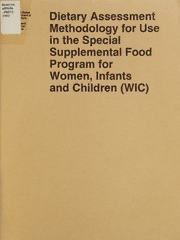
Dietary assessment methodology for use in the Special Supplemental Food Program for Women, Infants and Children (WIC) PDF
Preview Dietary assessment methodology for use in the Special Supplemental Food Program for Women, Infants and Children (WIC)
Historic, Archive Document Do not assume content reflects current scientific knowledge, policies, or practices. ~ Dietary Assessment - Methodology for Use in the Special — - Supplemental Food _ Program for Women, Infants and Children (WIC) AL.ANOV. .. This project has been funded at least in part with Federal funds from the Food and Nutrition Service, U.S. Department of Agriculture, under Cooperative Agreement #58-3198-0-048 under the guidance of: : The Department of Maternal and Child Health Harvard School of Public Health 677 Huntington Avenue . ~ Boston, Massachusetts 02115 a The final project report was prepared by: Jane D. Gardner Carol J. Suitor Jelia Witschi Qiang Wang Many individuals made substantial contributions of time and effort to assist in the project’s development of dietary assessment tools for low-income mothers and children. The project team wants to express its sincere thanks to the WIC participants who graciously took the time to complete food frequency questionnaires and provide feedback on them. The team also wants to recognize the valuable contributions made by WIC personnel in the Greater Boston Area and to thank them for their cooperation. These people include: Jan Kallio, Laurie Bissett, Janice Kildahl, Maria Serra, Clare McLaughlin and Patrick Healy. Others who gave generously of their time to review documents, give consultation, or participate in field observations were Karen Peterson, Michelle Harris, Patricia Guenther, Stephen Jobe, Cecelia Bennett, Candice Stoiber, Virginia Casey, Jean Wiecha, and Janet Washington. Special recognition is given to Brenda Lisi, Contracting Officer’s Representative, and Michele Lawler, of Nutrition and Technical Services Division, Rhonda Kane of the Supplemental Food Program Division, and Ellen Harris of the Office of Analysis and Evaluation at the Food and Nutrition Service, USDA, for their input in this project and critical review of this report. The contents of this publication do not necessarily reflect the view or policies of the U.S. Department of Agriculture, nor does mention of trade names, commercial products, or organizations imply endorsement by the U.S. SATE April 1992 CONTENTS INTRODUCTION A. RATIONALE FOR THE STUDY Scope of Report Project Objectives BACKGROUND INFORMATION OVERVIEW OF THE WIC PROGRAM Benefits Provided by the WIC Program WIC Program at Local Agency Level LITERATURE REVIEW A. FOOD FREQUENCY QUESTIONNAIRES B. DIETARY ASSESSMENT FOR CHILDREN C. SCORING FOOD FREQUENCY QUESTIONNAIRES REVIEW OF THE STATE WIC FOOD FREQUENCY QUESTIONNAIRES A. STATE AGENCY QUESTIONNAIRES B. FINDINGS FROM THE STATE WIC FOOD FREQUENCY QUESTIONNAIRES Scoring Methods Instructions for Scoring Design Features Determination of the Number of Foods Per Food Group Order of Presentation Food Groups ae S DEPT. O AGRICUL FULTURAL LIBRA SONAL: AGRI A | 8 1982 “ QATALOGING PREP. x a es oe IV. DEVELOPMENT OF THE FOOD FREQUENCY QUESTIONNAIRE FOR WOMEN A. REVIEW OF DATA FROM PFFQ Food List Portion Size Format B. FINDINGS FROM THE CSFII DATA ON LOW-INCOME WOMEN C. FIELD OBSERVATIONS OF WFFQ Sites Administration of the Women’s Food Frequency Questionnaire Findings DEVELOPMENT OF A FOOD FREQUENCY QUESTIONNAIRE FOR CHILDREN: ANALYSIS OF DATA FROM THE CONTINUING SURVEY OF FOOD INTAKE BY INDIVIDUALS A. METHODOLOGY Identification of the Most Commonly Used Foods Identification of Median Portion Size for Children B. FINDINGS FROM THE CSFII DATA Food Use by Children Portion Size C. FIELD OBSERVATIONS OF CFFQ Administration of the Children’s Food Frequency Questionnaire Findings from Field Observation DEVELOPMENT OF A MANUAL SCORING METHOD A. BACKGROUND INFORMATION Workshop on Manual Scoring Challenges in Manual Scoring Methods Oe 8 1 ia, THE SCORING METHOD Based on Minimum Number of Servings By Food Group Revisions of the Questionnaires to Accommodate Manual Scoring Assumptions Concerning Portion Sizes Correspondence With Servings Specified in Dietary Guidelines for Americans Overestimation and Underestimation Changing Cutoff Points FIELD OBSERVATIONS OF THE MANUAL SCORING METHOD Methods Scoring Times Accuracy DEVELOPMENT OF THE COMPUTER SOFTWARE (WIC ENTER) A. BACKGROUND OF SOFTWARE PROGRAM B. CHANGES IN DATA BASES IMPROVEMENTS IN SOFTWARE DESIGN AND ANALYSIS Field Observations of WIC ENTER FINAL RESULTS AND CONCLUSIONS THE FOOD FREQUENCY QUESTIONNAIRES Advantages of the Questionnaires Limitations of the Questionnaires MANUAL SCORING METHOD COMPUTERIZED SCORING METHOD Computer Software WIC ENTER Computerized Analysis CONCLUSIONS Testing and Future Evaluation Customizing the Instruments for Specific Needs Improving the Quality of Food Frequency Questionnaires Planning for Expanded Monitoring of Specific Nutrients and Other Food Components Self-Administered and Computerized Questionnaires iv LIST OF TABLES 100 Most Common Foods Consumed by Low-income Women, CSFII 1985 One-day Data 26 Percent Distribution of Race/Ethnicity of Clients at the Field Observation Sites 28 100 Most Common Foods Consumed by Children Aged 1 to 5 Years, CSFII 1985 One-day Data 36 Food Portion Size in Gram Weight Assigned to Foods in the WFFQ and CFFQ 39 Manual Scoring Time in Minutes by Project Team and Others 54 Check List for Dietary Data Collection Instruments 70 i vio oN Me » PROC Tee Ssen.| teas ' a | sly , = > + 1 a '" ite 7
